Posted in: 05/26/2022
The Índice de Desenvolvimento da Família (Family Development Index) (IDF) of the Unified Registry for Social Programs of the Federal Government (Cad Único) has been widely cited in academic studies on poverty and social policies.
For Synergia, the index has an important function in the performance of technical work, showing itself to be a synthetic social indicator applicable also to challenges faced in the private sector. Especially, when the company’s interest is to compensate for adverse impacts that affect people, families and/or communities in vulnerable situations through differentiated measures.
But before talking about the IDF, it is worth bringing up some observations about the use of synthetic social indicators as a whole, demonstrating their construction process and effective application. To this end, we will illustrate, through the work done by Synergia, how these indexes can be used.
Synergia has worked widely with technical solutions that explore the use of synthetic social indicators, either in the preparation of diagnoses (individual, by interest groups, local and/or municipal), social investment targeting, planning of services to families impacted by projects (prioritization criteria), monitoring and evaluation of social and environmental programs, etc.
There are various methods for constructing synthetic social indicators. In common, they all bring the logic of grouping a series of basic indicators, assigning limits (lower and upper) and statistical weights. Many of them are already known and published daily in the media. They are:
It is in this context that the Índice de Desenvolvimento da Família (Family Development Index) gains prominence.
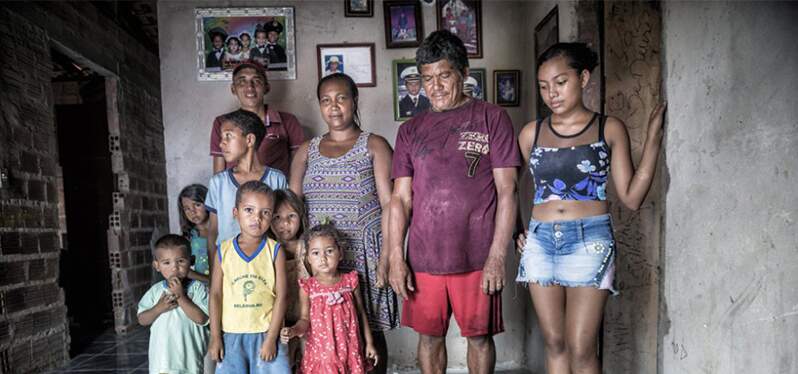
The IDF aggregates different means by which households meet their needs. Its value ranges from zero to one (0 – 1), the better the conditions of the family, the closer to one (1) its indicator will be.
The Índice de Desenvolvimento da Família (Family Development Index) was elaborated from 41 basic indicators, 22 components, and 6 dimensions, as shown in Table 1 below. Each component is calculated by the arithmetic mean of its indicators. In the same way, each dimension is calculated by the arithmetic mean of its components, and, finally, the synthetic indicator is calculated by the arithmetic mean of its dimensions. In other words, IDF treats all dimensions and components in a symmetrical way.
| Dimension | Component | Indicator |
| Vulnerability | Pregnancy and Breastfeeding | Absence of pregnant woman |
| Absence of breastfeeding mothers | ||
| Children, adolescents and youth | Absence of children (0 – 6 years) | |
| Absence of children and adolescents (7-14 years old) | ||
| Absence of children, adolescents and youth (7-17 years) | ||
| Disabled and elderly people | Absence of disabled people | |
| Absence of elderly people | ||
| Economic dependence | Presence of a spouse | |
| More than half of members are of working age | ||
| Access to knowledge | Illiteracy | Absence of illiterate adults |
| Absence of functionally illiterate adults | ||
| Education | Presence of at least one adult person with complete basic education | |
| Presence of at least one adult person with complete secondary education | ||
| Presence of at least one adult person with some higher education | ||
| Access to Work | Availability to work | More than half of the working-age members are employed |
| Quality of jobs | Presence of at least one employee in the formal sector | |
| Presence of at least one person engaged in a non-agricultural activity | ||
| Remuneration | Presence of at least one employed person with income higher than 1 SM | |
| Presence of at least one person with income above 2 MW | ||
| Availability of resources | Extreme Poverty | Per capita family expenditure above the extreme poverty line (1/4 minimum wage) |
| Per capita family income above the extreme poverty line (1/4 minimum wage) | ||
| Expenditure with food above the extreme poverty line (1/4 minimum wage) | ||
| Poverty | Per capita family expenditure above the poverty line (1/2 minimum wage) | |
| Per capita family income above the poverty line (1/2 minimum wage) | ||
| Income generation capacity | Most of the income does not come from transfers | |
| Child Development | Early work | Absence of at least one child under the age of 10 working |
| Absence of at least one child under 16 working | ||
| Access to school | Absence of at least one child aged 0 – 6 years out of school | |
| Absence of at least one child aged 7-14 years out of school | ||
| Absence of at least one child aged 7-17 out of school | ||
| School Progress | Absence of at least one child up to 14 years of age more than 2 years late | |
| Absence of at least one illiterate adolescent aged 10 to 14 years | ||
| Absence of at least one illiterate youth aged 15 to 17 | ||
| Housing Conditions | Home ownership | Own domicile |
| Own, assigned and invaded domiciles | ||
| Housing Deficit | Density of up to two residents per room | |
| Habitability | Permanent Building Material | |
| Adequate access to water | Adequate water supply | |
| Adequate access to sanitation and sewage disposal | Adequate sanitary sewage | |
| Access to garbage collection | Garbage is collected | |
| Access to Electricity | Access to Electricity |
Table 1 – Dimensions, components, and indicators of the Índice de Desenvolvimento da Família (Family Development Index) (IDF). Source: Adapted from BARROS et al, 2009.
The “vulnerability” of a family can be associated with the additional amount of resources it requires to meet special needs compared to what would be required by a standard family.
Among the possible examples, the presence of pregnant or lactating women in the family requires special nutritional and medical care needs. Families with children, adolescents, and young people incur additional expenses related to the transmission of rules, living habits, daily care, and specific educational and medical needs. For people with disabilities there is a need for safety, daily care, and specialized medical care (BARROS et al., 2009)[1].
The other dimensions of the IDF contemplate other means that a family may have at its disposal to satisfy its needs, for example, the “access to knowledge“, which involves components and basic indicators on illiteracy and schooling.
Access to work” represents the opportunity that people have to use their productive capacity, and therefore includes data on the availability of work, job quality, and payment.
Many of the needs of households can be met through goods and services purchased in the market, so income poverty indicators become a key resource in determining well-being and addressing the “availability of resources” dimension.
It is important to differentiate the portion of the proceeds generated autonomously income from the share of income that is received as transfers from the government and other households, thus measuring the sustainability and degree of financial independence of that household.
One of the main goals of any society is to guarantee every child opportunities for full development. The “child development” dimension captures information on early work, access to school, and school progress.
Finally, “housing conditions” represent the living conditions of a family and are closely related to health conditions, grouping components on the property, housing deficit, housing conditions, access to water supply, access to sanitation, access to garbage collection, and access to electricity (BARROS et al., 2009).
Synergia has already used the Family Development Index in multiple contexts.
For the elaboration of diagnoses, for example, the indicator enables territorial analyses at different levels (local, regional, and municipal), by groups of interest (common impacts or similarity criteria), and individualized diagnoses (families).
One of the advantages of the IDF is the possibility to compare results produced in the field (primary data) and secondary sources. When diagnosing the main needs of a community, one can compare them with the municipality to which it belongs, as in the hypothetical example in Graph 1.
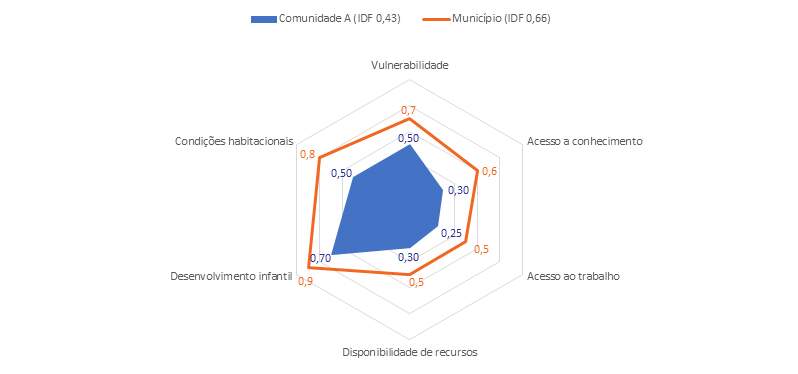
One can see a community with even worse living conditions than the municipality where it is located. The municipal data can be obtained from the Cadastro Único para Programas Sociais do Governo Federal (CadÚnico) (Unified Registry for Social Programs of the Federal Government), of the Ministério da Cidadania (Ministry of Citizenship).
The CadÚnico, besides selecting families for income transfer programs, also functions as a census of the poorest population of the country, because it gathers information from 33.7 million families with a per capita income of up to half a minimum wage or a total family income of 3 minimum wages.
In other words, the indicator shows itself as an interesting tool to direct social investments by private companies, just as the CadÚnico uses it to elect the most effective interventions and to evaluate the impact of these interventions (performance of local administrations).
In works about the involuntary removal of people, families and/or communities impacted by enterprises, the indicator has shown itself effective to identify the need for assisted services through programs that seek to restore livelihoods, as complementary support to the payment of monetary compensation.
In the very planning of assisted care for physically and economically displaced families, the IDF can be used as a prioritization criterion, as it allows for an isonomic comparison. Its value ranges from zero to one. The worse the socioeconomic conditions of the family, the closer to zero its indicator will be, and therefore the greater the urgency to repair the impacts of the removal.
The following graph exemplifies, using hypothetical data, the comparison of the IDF between family A (0.39) and the set of impacted families (0.59). It can be seen that the highlighted family is in a disadvantageous situation compared to the other impacted families – especially with regard to the dimensions of access to work, access to knowledge, and availability of resources.
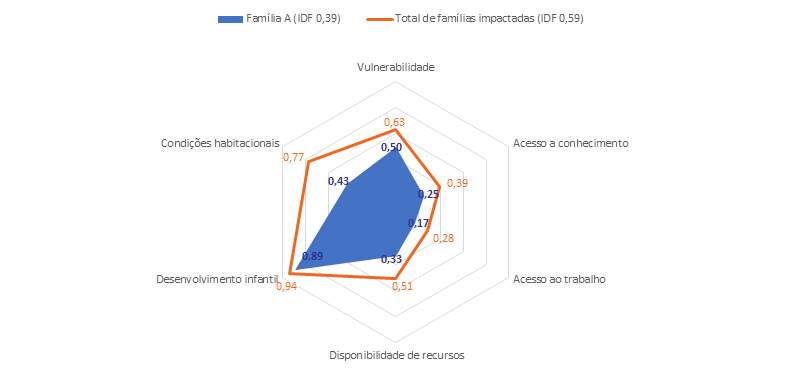
The assisted assistance modality includes programs of social accompaniment (including psychosocial support), search for real estate suitable to the family’s needs, preservation of social and organizational practices, productive restructuring, business plans, among other differentiated measures that apply to families in vulnerable situations.
The importance of giving special attention to disadvantaged groups whose basic needs are not being met is recognized. Once again, the IDF shows itself to be an important analytical tool to identify the family’s main needs and, therefore, to frame it as a public of interest for programs that aim to reestablish living conditions.
To monitor and evaluate the results of these measures, Synergia has already incorporated the IDF into indicator monitoring systems, in order to show that the living conditions of people, families and/or impacted communities are at equivalent or better levels than those verified before the involuntary removal process.
The IDF allows the comparative analysis between the situation before (diagnostic baseline) and after the execution of the service plan (in general, through periodic campaigns over 24 months).
Sometimes, indicator monitoring programs are linked to the conditions of environmental licenses, and the use of IDF gives technical reliability to the responsible agencies in measuring the results.
This article sought to share some technical solutions already explored at Synergia using synthetic social indicators. In particular, the Índice de Desenvolvimento da Família (Family Development Index) (FDI) has been explored in territorial analysis, by interest groups, and individualized diagnoses.
In involuntary family removal works, the indicator is effective in identifying situations of vulnerability and the need for assisted care.
During the planning of programs complementary to cash compensation, the IDF can be used as a prioritization criterion, as it allows for an isonomic comparison.
To monitor and evaluate results of these care measures, the IDF allows evidencing living conditions of impacted people, families and/or communities at levels equivalent or better than those verified before the removal process.
Certainly, the text does not exhaust the possibilities of using the IDF, nor does it consider it to be the only possible indicator for the types of work cited. What we want to highlight is the method for constructing synthetic social indicators, through the logic of grouping basic indicators, defining limits (lower and upper) and assigning statistical weights.
We need to consider that the transformation of data into useful information and shared knowledge are continuous processes. But what good is the accumulation of data when it is not applied to practical solutions experienced in the territories where we operate? What is the use of a cadastral survey of people, families and/or communities, when we don’t explore its diagnostic and measurement function of the investigated phenomena?
Facing the emergence of a new culture of indicators, where information management takes on a central role in the evaluation of impacts, the mastery of quantitative data sources has become fundamental to measure the reach of the actions carried out.
The time when leaders in public administration and private enterprise could make decisions without assessing the externalities produced on the collectivities they govern or influence is long gone.
Who knows, the examples brought in this article may serve as an incentive for the construction of new indexes, capable of measuring the investigated phenomena, subsidizing the decision making process, and measuring the reach of the performed actions.
Text prepared by Vinicius Corrêa – Project Manager
[1] BARROS, R. P.; CARVALHO, M.; MENDONÇA, R. Sobre as utilidades do Cadastro Único. Text for Discussion No. 1414. Rio de Janeiro: IPEA, 2009.
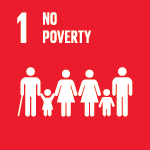
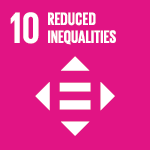
Sign up and receive our news.